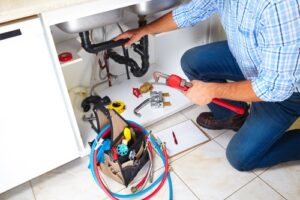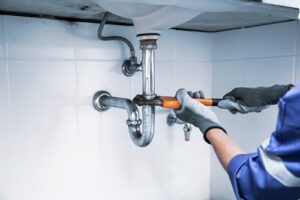When the unexpected strikes in the realm of homeownership, few things can disrupt the domestic tranquility as swiftly as plumbing issues. A leaky pipe or a stubborn clog has an uncanny ability to turn a serene household into a scene of controlled chaos, but there can be many serious issues in which a homeowner will need to look into finding a plumber near me.
In these moments of plumbing peril, the timeliness of a professional response becomes paramount. The question that echoes through the corridors of concern is, “How quickly can a residential plumber come to the rescue and restore the harmony of a home?”
In this article, we delve into the dynamics of residential plumbing emergencies and explore the factors that influence the speed at which a skilled plumber can address specific issues. From burst pipes demanding immediate attention to routine maintenance concerns, we navigate the currents of homeowner anxieties and seek to shed light on the ways in which plumbing professionals offer swift solutions to keep the waters calm.
Join us as we unravel the tapestry of responsiveness woven by residential plumbers, aiming to understand the timelines, considerations, and strategies involved in their mission to salvage the sanctity of home spaces.
The Nature of the Plumbing Issue
The speed at which a residential plumber can assist homeowners is significantly influenced by the nature of the plumbing issue at hand. Plumbing problems vary widely, ranging from minor inconveniences to urgent emergencies that demand immediate attention.
Routine maintenance tasks, such as fixing a minor leak or clearing a clogged drain, are common issues that homeowners encounter. While these may not be immediate emergencies, the speed of a plumber’s response can still play a crucial role in preventing these seemingly small problems from escalating into more significant and costly issues. Timely attention to routine maintenance ensures that potential threats are addressed before they transform into major disruptions.
On the other end of the spectrum are plumbing emergencies, such as burst pipes. These situations demand swift and decisive action to minimize damage to the property. The urgency is inherent, and a plumber’s ability to respond promptly becomes paramount in preventing extensive water damage and preserving the structural integrity of the home.
The nature of the plumbing issue also influences the level of expertise and equipment required for resolution. Simple tasks may be tackled swiftly, while more complex problems demand a meticulous approach, potentially elongating the time needed for a comprehensive diagnosis and solution.
In essence, the interplay between the urgency and complexity of a plumbing issue forms the backdrop against which a residential plumber operates. Homeowners, armed with an understanding of these dynamics, can better communicate the urgency of their situation to plumbing professionals, ensuring a more accurate and efficient response tailored to the specific nature of their plumbing predicament.
Understanding Emergency Plumbing Service
Emergency plumbing services are designed to address urgent and time-sensitive plumbing issues that require immediate attention. Here’s a step-by-step explanation of how emergency plumbing services typically work for homeowners unfamiliar with the workflow of a residential plumber.
Initial Contact:
When faced with a plumbing emergency, the homeowner initiates contact with a plumbing service that offers emergency assistance. This can be done through a phone call, online form submission, or even a mobile app, depending on the plumber’s communication channels.
Information Gathering:
The homeowner provides essential information about the nature of the plumbing emergency. Clear and detailed information helps the plumbing service understand the severity of the issue and dispatch the appropriate resources.
Assessment and Prioritization:
Based on the information provided, the plumbing service assesses the urgency of the situation. Emergencies like burst pipes, major leaks, or sewage backups are typically prioritized for immediate attention due to their potential for extensive damage.
Dispatching a Plumber:
Once the urgency is determined, the plumbing service dispatches a qualified and equipped plumber to the homeowner’s location. Many plumbing services have dedicated emergency response teams or provide 24/7 service to ensure timely assistance.
On-Site Evaluation:
Upon arrival, the plumber conducts an on-site evaluation of the plumbing emergency. This involves identifying the source of the problem, assessing the extent of damage, and understanding the necessary steps for resolution.
Immediate Repairs or Temporary Solutions:
In many cases, emergency plumbers aim to implement immediate repairs or temporary solutions to contain the issue and prevent further damage. This may involve shutting off water supplies, patching leaks, or addressing other critical aspects of the problem.
Detailed Diagnosis:
After mitigating the immediate emergency, the plumber conducts a more detailed diagnosis to identify the root cause of the problem. This may involve using specialized equipment, such as cameras for inspecting pipes, to uncover hidden issues.
Comprehensive Repair Plan:
Once the plumber has a comprehensive understanding of the plumbing issue, they communicate with the homeowner to discuss a detailed repair plan. This may include long-term solutions, replacement of damaged components, or additional preventive measures to avoid future emergencies.
Documentation and Communication:
The plumber provides documentation of the work performed, including details of repairs, replaced parts, and any recommendations for ongoing maintenance. Clear communication ensures that the homeowner is informed about the status of their plumbing system.
Follow-Up:
Some plumbing services follow up with homeowners after the emergency to ensure that the repairs are holding up and there are no further issues. This step reinforces customer satisfaction and provides peace of mind.
Understanding the workflow of emergency plumbing services helps homeowners navigate unexpected crises effectively and ensures a swift and efficient resolution to urgent plumbing problems.
Consider Proximity and Location for the Time it Takes for Plumber Help
The location of both the plumber and the homeowner plays a crucial role in determining how quickly a professional can assist with a plumbing issue. Here are the key factors influenced by location.
Proximity:
The physical distance between the plumber’s location and the homeowner’s residence directly impacts response time. Local plumbers or those in close proximity can typically reach the site more quickly than those located farther away. Proximity becomes particularly crucial in emergency situations where swift action is essential to minimize damage.
Service Area Coverage:
Plumbers usually define a specific service area that outlines where they can efficiently provide their services. Homeowners residing within or near this service area can expect quicker response times, as plumbers are familiar with local infrastructure, regulations, and can navigate the area more efficiently.
Availability of Local Plumbers:
The availability of local plumbers in a specific region also influences response time. In areas with a high concentration of plumbing professionals, homeowners may have more options and faster access to assistance, especially during peak demand periods.
Traffic and Transportation:
Urban congestion or rural accessibility challenges can impact how quickly a plumber can reach a homeowner’s location. Traffic conditions, road closures, or difficult-to-navigate terrains can add delays. Plumbers often consider these factors when estimating their arrival time.
Emergency Response Times:
In emergency plumbing situations, such as burst pipes or severe leaks, the location becomes even more critical. Emergency plumbers or services offering 24/7 support may have dedicated teams strategically positioned to respond rapidly to urgent calls. Homeowners in close proximity to these emergency teams can benefit from quicker assistance.
Remote or Rural Areas:
Homeowners in remote or rural areas may experience longer response times due to the limited availability of local plumbing services. Plumbers may need to travel greater distances, and logistical challenges can contribute to delays.
Availability of Parts and Supplies:
The availability of plumbing parts and supplies in the local area can impact repair times. Plumbers located in regions with better access to suppliers may be able to acquire necessary materials more quickly, reducing the overall time required for repairs.
To expedite the process and ensure swift assistance:
- Homeowners can proactively choose local plumbing services.
- Plumbers can optimize their scheduling and routes to minimize travel time.
- Both parties can communicate openly about location details and potential challenges that may affect response times.
Considering the location factors helps homeowners and plumbers collaborate effectively, ensuring timely and efficient resolution of plumbing issues.
In the dynamic world of residential plumbing, where the unexpected can disrupt the tranquility of any home, the speed at which a professional plumber responds becomes a defining factor in mitigating potential chaos. As we explored the intricacies of how quickly a residential plumber can assist homeowners with specific issues, it becomes evident that time is of the essence in averting further damage and restoring the serenity of living spaces.
Whether facing routine maintenance tasks or plumbing emergencies demanding immediate attention, homeowners can navigate these waters with confidence by understanding the factors influencing the swift response of a skilled plumber. The nature of the issue, the plumber’s proximity, and the efficiency of communication all contribute to the timely resolution of plumbing predicaments.
In this journey through the pipelines of residential plumbing, we’ve unveiled the importance of clear communication, proactive maintenance, and the strategic positioning of local plumbers in ensuring swift assistance. By recognizing the interplay between urgency and expertise, homeowners can forge a partnership with plumbing professionals that transforms potential crises into manageable challenges.
As we conclude this exploration, it is evident that the collaborative efforts between homeowners and plumbers are instrumental in the swift resolution of plumbing issues. Armed with knowledge, homeowners can make informed decisions, while plumbers equipped with skills and efficiency can swiftly navigate the twists and turns of plumbing emergencies. In the fluid landscape of residential plumbing, the key to peace of mind lies in the seamless, rapid response that transforms chaos into calm, one well-timed repair at a time.

